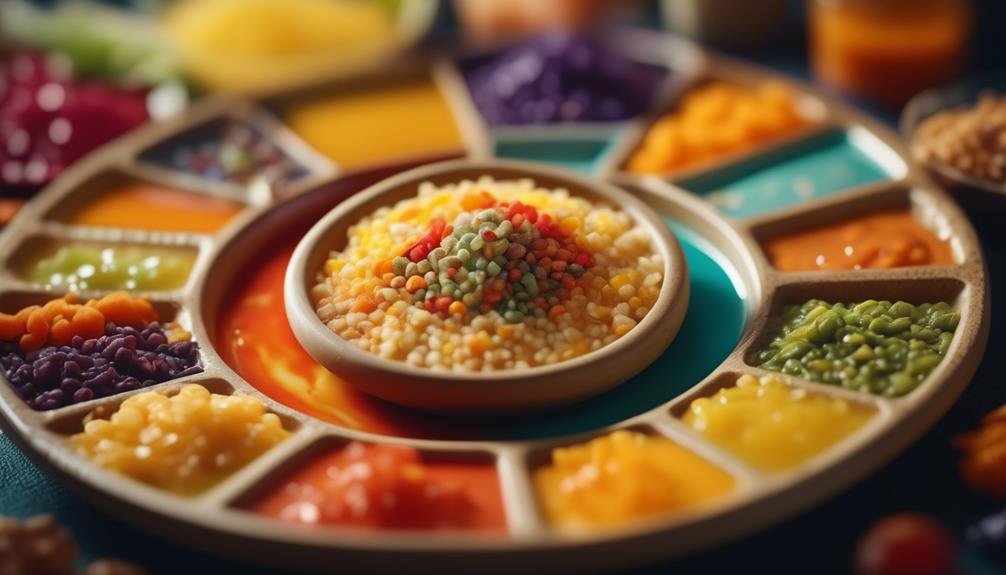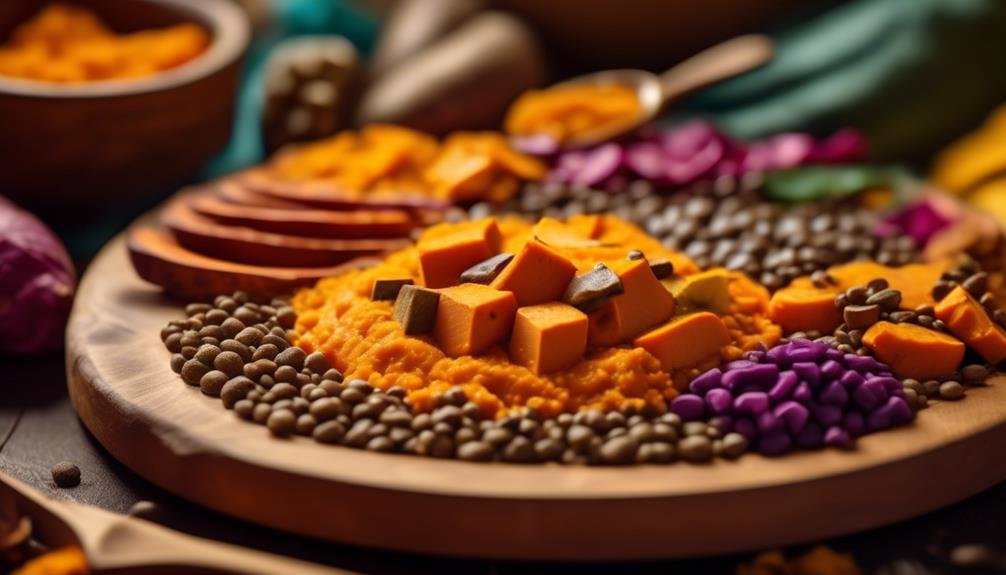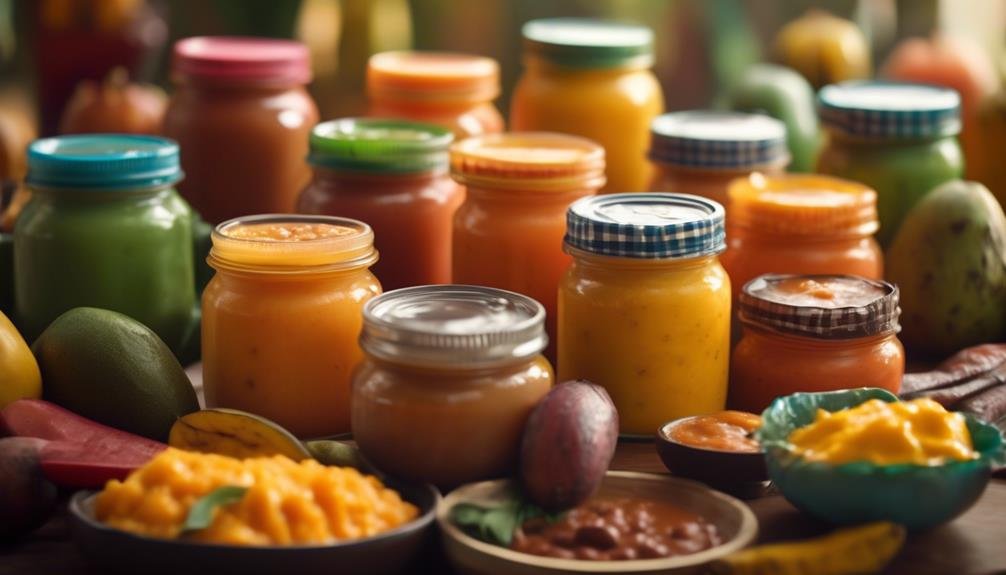"Cherishing Little Steps - A Haven for Baby and Family Journeys"
Culturally Diverse Baby Foods
Are you concerned that introducing culturally diverse baby foods may be too adventurous for your little one?
While it's natural to have reservations about trying new flavors, exposing your baby to a variety of tastes and textures can actually be beneficial for their development.
In fact, research suggests that early exposure to diverse flavors can help expand their palate and increase the likelihood of them enjoying a wider range of foods as they grow older.
So, why not embark on a culinary journey with your baby and discover the world of culturally diverse baby foods?
From traditional recipes from around the world to fusion creations that mix cultures for unique flavors, there's a whole universe of delicious and nutritious options waiting to be explored.
Key Takeaways
- Introducing diverse flavors and textures to infants can expand their palate and reduce picky eating habits.
- Cultural diversity in baby foods promotes appreciation, understanding, and a sense of global awareness and acceptance.
- Culturally diverse baby foods provide a rich source of nutrients and vitamins, contributing to a well-balanced and nutritious diet.
- Incorporating indigenous ingredients and fusion baby foods not only provide nutritional value but also support cultural appreciation, flavor exploration, and environmental sustainability.
Introduction to Culturally Diverse Baby Foods

Get ready to embark on a journey exploring the world of culturally diverse baby foods, delving into the rich tapestry of flavors, ingredients, and feeding practices from different cultures around the globe. As we begin our exploration, let's first discuss the introduction to culturally diverse baby foods.
Introducing culturally diverse baby foods involves introducing infants to a wide range of flavors and textures from various cultures. This practice not only exposes babies to new tastes but also plays a significant role in their development. Research shows that early exposure to different flavors can help infants develop a more adventurous palate, increase their acceptance of diverse foods, and reduce the likelihood of developing picky eating habits later in life.
Furthermore, culturally diverse baby foods offer numerous benefits. They provide a unique opportunity to celebrate and preserve cultural traditions and culinary heritage. By introducing babies to the flavors and ingredients of different cultures, we foster an appreciation for diversity and promote cultural understanding from a young age.
Additionally, exposing infants to a varied diet from different cultures can help prevent nutrient deficiencies and promote a well-rounded, balanced diet.
Benefits of Introducing Cultural Flavors to Your Baby
As we continue our exploration of culturally diverse baby foods, let's now explore the numerous benefits that come from introducing your baby to a wide array of cultural flavors. Introducing new tastes to your baby not only expands their culinary horizons but also offers a range of advantages for their development and future eating habits.
| Benefits | Explanation |
|---|---|
| Enhances taste preferences | Exposing your baby to different cultural flavors early on can help develop their taste buds and preferences. |
| Promotes acceptance of diverse foods | Introducing a variety of flavors from different cultures can make your baby more accepting of a diverse diet. |
| Encourages exploration and curiosity | Trying new tastes can spark curiosity in your baby, encouraging them to explore and be open-minded about food. |
| Develops cultural awareness | Introducing cultural flavors can help your baby develop an understanding and appreciation for different cultures. |
| Supports a healthy and balanced diet | Offering a wide range of flavors ensures that your baby receives a diverse range of nutrients for their growth. |
Traditional Baby Foods From Around the World

Traditional baby foods from around the world offer a fascinating glimpse into the diverse and rich culinary traditions of different cultures. These traditional foods aren't only delicious but also packed with essential nutrients for your baby's growth and development. Let's explore some of the traditional baby foods from around the world and discover the unique cooking techniques and nutritional benefits they offer:
- Congee (China): This rice porridge is a staple in Chinese cuisine. It's cooked slowly over low heat, resulting in a smooth and creamy texture. Congee is easy to digest and provides a good source of carbohydrates and protein for your little one.
- Arepas (Venezuela): Arepas are cornmeal patties that are grilled or baked. They're a popular choice for babies in Venezuela due to their soft and chewy texture. Arepas are rich in fiber and provide a good source of energy.
- Dhal (India): Dhal is a lentil stew that's a common first food for babies in India. It's cooked with a variety of spices and served with rice or roti. Dhal is a great source of protein and essential vitamins and minerals.
- Mashed Plantains (Caribbean): In the Caribbean, mashed plantains are a favorite baby food. Plantains are boiled and then mashed into a smooth consistency. They're a good source of potassium and dietary fiber.
Exploring Asian-Inspired Baby Food Recipes
Exploring the rich culinary traditions of Asia, discover a wide array of culturally diverse baby food recipes that provide a blend of unique flavors and essential nutrients for your little one's growth and development. Introducing diverse flavors to babies is crucial as it helps expand their palate and encourages them to develop a taste for a variety of foods. Asian-inspired baby food recipes offer an excellent opportunity to introduce new flavors and textures to your child's diet.
Asian cuisine is known for its use of fresh ingredients and aromatic spices, which not only enhance the taste of the food but also bring along a plethora of health benefits. For example, ginger, commonly used in Asian cooking, can help alleviate digestive issues, while turmeric, often found in Indian cuisine, is known for its anti-inflammatory properties. By incorporating these ingredients into your baby's meals, you aren't only exposing them to a different cultural experience but also providing them with essential nutrients that promote their overall health and well-being.
Moreover, Asian-inspired baby food recipes often include a variety of vegetables, such as bok choy, edamame, and seaweed, which are rich in vitamins, minerals, and fiber. These nutrient-dense ingredients support your baby's growth and development, including their immune system, brain development, and bone health.
African-Influenced Baby Food Ideas

With a shift in culinary inspiration, let's now explore the vibrant and diverse world of African-influenced baby food ideas, offering a unique blend of flavors and cultural significance for your little one's palate. African cuisine is rich in tradition and history, and incorporating these flavors into your baby's meals can introduce them to a whole new world of tastes.
Here are four African-inspired baby food recipes that highlight traditional African ingredients:
- Sweet Potato and Peanut Puree: This creamy and nutritious puree combines the sweetness of sweet potatoes with the nutty richness of peanuts. It's a popular dish in West African cuisine and provides a good source of essential nutrients for your baby's growth.
- Plantain Porridge: Plantains are a staple in many African countries and are a great source of dietary fiber and potassium. Boiled and mashed, they create a smooth and easily digestible porridge that can be flavored with spices like cinnamon or nutmeg.
- Spinach and Pumpkin Mash: Leafy greens are a vital part of African cuisine. This mash combines the iron-rich goodness of spinach with the natural sweetness of pumpkin, creating a nutritious and delicious meal for your little one.
- Millet Cereal: Millet is a widely consumed grain in Africa, known for its high nutrient content. Ground into a fine powder and cooked with water or milk, it can be served as a creamy cereal, providing your baby with essential vitamins and minerals.
European-Inspired Baby Food Recipes
European cuisine offers a wealth of diverse flavors and culinary traditions that can be adapted to create delicious and nutritious baby food recipes. By incorporating indigenous ingredients into baby food, you can introduce your little one to the rich cultural heritage of Europe while providing them with essential nutrients. From the hearty stews of Ireland to the delicate pastas of Italy, there is a vast array of European-inspired baby food recipes to explore.
To give you some inspiration, here are a few examples of European-inspired baby food recipes:
| Recipe | Ingredients |
|---|---|
| Spanish Gazpacho | Tomatoes, cucumbers, bell peppers, olive oil, garlic |
| French Ratatouille | Eggplant, zucchini, bell peppers, tomatoes, herbs |
| Italian Minestrone | Carrots, celery, tomatoes, beans, pasta, herbs |
| Greek Tzatziki Yogurt | Greek yogurt, cucumber, garlic, lemon juice, dill |
These recipes not only introduce your baby to new flavors and textures but also provide them with a variety of vitamins, minerals, and antioxidants. By using locally sourced and seasonal ingredients, you can ensure that your baby's meals are fresh and nutritious.
Exploring European-inspired baby food recipes allows you to embrace the diversity and cultural richness of the continent. It also encourages a love for different cuisines from an early age, promoting an adventurous palate and an appreciation for the world around us. So go ahead, try these recipes and embark on a culinary journey through Europe with your little one.
Latin American-Inspired Baby Food Options

Drawing inspiration from the rich culinary traditions of Europe, now let's turn our attention to the vibrant flavors and diverse ingredients of Latin American-inspired baby food options. Latin American cuisine is known for its bold and exciting flavors, making it a perfect choice for introducing cultural flavors to picky eaters.
Here are four Latin American-inspired baby food recipes that will tantalize your little one's taste buds:
- Avocado and Banana Mash: This creamy and nutritious combination is a popular choice in Latin American countries. Avocado provides healthy fats and bananas offer natural sweetness, making it a delicious and nutritious option for your baby.
- Black Bean Puree: Rich in protein and fiber, black beans are a staple in Latin American cuisine. This puree isn't only packed with nutrients but also has a smooth and creamy texture that your baby will love.
- Quinoa and Sweet Potato Bowl: Quinoa, a nutritious grain native to South America, pairs perfectly with sweet potatoes, creating a balanced and flavorful meal for your baby. This dish is a great way to introduce different textures and flavors.
- Mango and Papaya Smoothie: Tropical fruits like mango and papaya are commonly found in Latin American countries. Blend these fruits together to create a refreshing and vitamin-rich smoothie that your baby will enjoy.
Middle Eastern Flavors for Your Baby's Palate
Middle Eastern cuisine offers a rich tapestry of flavors and ingredients that can introduce a world of new tastes to your baby's palate. The use of Middle Eastern spices in baby food not only adds a unique twist to meals but also exposes your little one to the diverse and vibrant culinary traditions of this region.
Middle Eastern spices, such as cumin, coriander, turmeric, and cinnamon, are known for their aromatic profiles and health benefits. These spices not only enhance the taste of baby food but also introduce them to the cultural diversity that exists in our global society.
When it comes to introducing Middle Eastern flavors to your baby, start with mild spices and gradually increase the intensity as their taste buds develop. For example, you can add a pinch of cumin to pureed carrots or sprinkle some cinnamon on their oatmeal. These small additions can make a big difference in expanding your baby's palate and encouraging them to embrace new flavors.
Incorporating Indigenous Ingredients Into Baby Food

To broaden your baby's culinary horizons, consider incorporating indigenous ingredients into their meals, allowing them to explore the diverse and unique flavors that different cultures have to offer. By incorporating traditional ingredients from different cultures, you not only introduce new tastes to your baby but also expose them to the rich cultural diversity in the baby food industry.
Here are four reasons why incorporating indigenous ingredients into your baby's meals can be beneficial:
- Nutritional Value: Indigenous ingredients often have unique nutritional profiles, packed with vitamins, minerals, and antioxidants. For example, incorporating ingredients like quinoa from South America or seaweed from Asia can provide your baby with a variety of essential nutrients.
- Cultural Appreciation: Introducing indigenous ingredients into your baby's meals allows them to develop an appreciation for different cultures from an early age. It helps them understand and respect the diverse culinary traditions that exist worldwide.
- Flavor Exploration: Indigenous ingredients bring a whole new set of flavors to your baby's palate. From the earthy taste of taro root in Hawaiian cuisine to the spiciness of ají pepper in Peruvian dishes, these ingredients can expand your baby's taste buds and create a lifelong love for diverse flavors.
- Environmental Sustainability: By incorporating indigenous ingredients, you can support sustainable agricultural practices and local farmers. Many traditional ingredients are grown organically and have a lower carbon footprint, contributing to a more environmentally friendly food system.
Incorporating indigenous ingredients into your baby's meals not only adds variety and nutrition but also fosters cultural appreciation and environmental sustainability. Embrace the cultural diversity in the baby food industry and let your baby embark on a flavorful journey.
Fusion Baby Foods: Mixing Cultures for Unique Flavors
Mixing cultures in baby food preparation can result in unique flavors and a rich culinary experience for your little one. As global baby food trends continue to evolve, the concept of fusion baby foods is gaining popularity. This innovative approach combines different cultural cuisines to create exciting and diverse flavors for your baby's palate.
Fusion baby foods offer a delightful blend of flavors that go beyond traditional recipes. By incorporating elements from various cultural cuisines, parents can introduce their little ones to a world of diverse tastes from an early age. For example, you can mix Indian spices with Mexican ingredients to create a flavorful fusion dish that your baby will love.
This trend isn't only about taste, but also about cultural context and a comparative study of different culinary traditions. It allows parents to expose their babies to a wide range of flavors, textures, and ingredients from around the world.
Tips for Introducing Culturally Diverse Baby Foods to Your Little One

When introducing culturally diverse baby foods to your little one, it's important to consider the unique flavors and culinary traditions that can be explored. By incorporating different cultural spices into your baby's diet, you can expose them to a wide range of tastes and aromas that will help develop their palate.
Here are some tips to help you introduce culturally diverse baby foods to your little one:
- Start slow: Begin by introducing small amounts of culturally diverse spices into your baby's meals. This will allow them to gradually adjust to new flavors without overwhelming their taste buds.
- Adapt dishes for baby friendly meals: Take traditional cultural dishes and modify them to make them suitable for your baby. For example, you can puree Indian curries or Mexican stews to make them easier for your little one to consume.
- Be mindful of allergies: Before introducing any new spices or ingredients, make sure to check for any potential allergies. Start with small amounts and monitor your baby's reaction closely.
- Embrace variety: Don't limit yourself to just one culture's cuisine. Explore different cultures and their unique dishes. By exposing your baby to a wide range of flavors, you aren't only expanding their culinary horizons but also promoting an appreciation for different cultures.
Frequently Asked Questions
How Long Does It Take for Babies to Adjust to New Flavors in Culturally Diverse Baby Foods?
It usually takes babies some time to adjust to new flavors. During this adjustment period, their flavor preferences may change as they are exposed to culturally diverse baby foods.
Are There Any Cultural Baby Foods That Are Not Recommended for Infants Due to Potential Allergies or Sensitivities?
Some cultural baby foods may not be recommended for infants due to potential allergies or sensitivities. Safety concerns are important when introducing new flavors, so it's crucial to research and consult with a pediatrician before trying them.
Can Culturally Diverse Baby Foods Be Introduced Alongside Traditional Baby Foods, or Should They Be Introduced Separately?
When introducing culturally diverse baby foods alongside traditional options, there are pros and cons to consider. It's important to be culturally sensitive in this process, as it can provide a rich and diverse palate for your baby.
Are There Any Specific Cultural Baby Foods That Are Considered More Nutritious or Beneficial for a Baby's Development?
Are there culturally specific baby foods that offer greater nutritional benefits for a baby's development? It's important to explore the potential advantages of introducing diverse cultural baby foods alongside traditional options, especially for infants with dietary restrictions.
What Are Some Tips for Incorporating Culturally Diverse Baby Foods Into a Picky Eater's Diet?
To make culturally diverse baby foods appealing to picky eaters, try these tips: 1) Start with small portions, gradually increasing variety. 2) Add familiar flavors to new dishes. 3) Involve your child in meal preparation. 4) Keep offering different options and be patient.
Conclusion
In conclusion, introducing culturally diverse baby foods to your little one can open up a world of flavors and experiences.
Just like a tapestry woven with threads from different cultures, these foods can enrich your baby's palate and provide a deeper understanding of the diverse world we live in.
So, let your baby's taste buds embark on a culinary journey, like a compass guiding them through the vibrant tapestry of global flavors.



Tadalafilo Cinfa 20 Mg Precio
(Moderator)
Cialis 5 mg prezzo cialis prezzo tadalafil 5 mg prezzo
Hi there! This is my 1st comment here so I just wanted to give a quick shout out and tell you I genuinely enjoy reading your blog posts. Can you recommend any other blogs/websites/forums that deal with the same subjects? Thanks for your time!
nodeposit365 bcasino
This text is invaluable. Where can I find out more?
booi casino login
Why users still use to read news papers when in this technological world all is presented on web?
www casino club online
Your article helped me a lot, is there any more related content? Thanks!